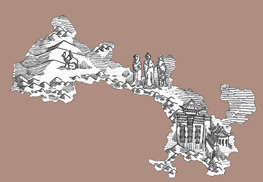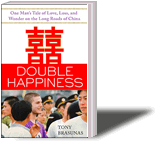Maps, and Why They’re Lovable
15 2010
Images enrapture us with a speed words rarely match. Paintings and photographs, in particular, seize our attention with the specific focus and totality of their image.
attention with the specific focus and totality of their image.
Movies go further, animating images, colors, objects, and faces, bringing them to life with such power that sounds and words become secondary.
(How long after taking in the images above and at right, did you begin reading these words?)
Books have no images, no pictures, no colors.* Books are all about the words, and for good reason: The impact of words takes longer to penetrate the heart and mind but can ultimately go far deeper.
Novels, biographies, memoirs — these genres particularly feature almost no illustration. There are exceptions, and one of these exceptions, to me, for travel books like mine, adds the perfect palpable grounding to otherwise purely verbal narratives.
Maps. Maps illustrate the changing landscape behind a narrative to underscore the moments when the motion of the story accelerates or slows, changes direction, or launches into wholly new territory. Great maps not only illustrate this motion, but also serve the role they serve when one is off wandering oneself: They illustrate the possibility of endless new frontiers.
These are the maps I love and have loved all my life — those that push our journeys, whether armchair or actual, farther into the unfamiliar.
I’m ambitious and excited about the maps for Double Happiness. Maps will begin many of the chapters, and I’ve now begun working with a professional illustrator to create each one by hand. She’s reading the full manuscript, and she’s adding people, landmarks, and characters from the narrative to the maps themselves, so that they don’t simply demonstrate the direction of movement through the changing landscape of China, but also pull together diverse elements of the story. I love maps that do this — that subtly push the journey into the spatial awareness of the reader.
I think you’ll love the maps that she’s creating. A very rough first version of her work is above, at right.
Do you have a favorite book that featured a map or that included many maps? I would love to know, to look at other maps, to understand what works and what doesn’t. Do tell! Leave a comment below.
* Hundreds of excellent picture books and graphic novels are duly excepted, of course. And don’t get me wrong: The paucity of images in books is essential. Much of the fun of reading is using our own minds as readers to paint the mental picture — the mental movie — in the way we want to watch it, with the author’s descriptions as just the canvas and palette with which we paint. The best reading is a creative collaboration between the reader and the writer.




Connect & Share